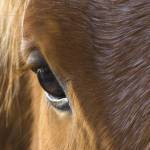Malignant Hyperthermia in Horses

Malignant hyperthermia (MH) is a genetic disorder of horses suggested to be an autosomal dominant trait.
MH is confined to Quarter Horses and members of related breeds such as Appaloosas and Paints. Less than 1% of Quarter Horses are affected, and those that are seem to trace to two specific bloodlines. Mature horses are usually affected, and there does not seem to be a gender predilection.
Clinical signs of MH include high body temperature, either under general anesthesia or in conjunction with an episode of tying-up, usually type 1 polysaccharide storage myopathy (PSSM).
To manage horses diagnosed with MH, it might be best to determine if they are also suffering from PSSM. If a dual-diagnosis is present, it is best to feed the horse in such a way that minimizes PSSM symptoms, namely the provision of a diet that is low in starch and high in fermentable fiber and fat.
Horses with both MH and PSSM are more difficult to manage than horses with only PSSM.
A nutritionist should evaluate the diet to ensure vitamin E and selenium levels are adequate. Both vitamin E and selenium function as antioxidants and each can offset a deficiency of the other as long as both are not deficient. Several studies have shown that water-soluble, natural vitamin E (d-alpha-tocopherol) is better absorbed than synthetic vitamin E and will more quickly achieve higher concentrations in the tissues.
Genetic testing for MH is available from the Neuromuscular Diagnostic Laboratory at the University of Minnesota.








